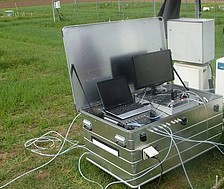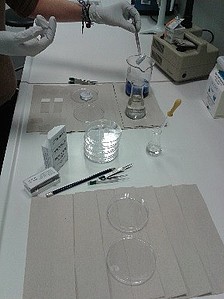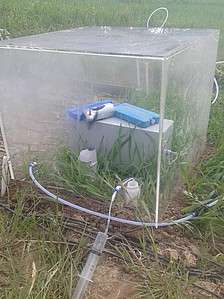The response of soil moisture to climate change as a key driver of changes in important agricultural ecosystem functions
Robert Kahle
Hohenheim Institute of Soil Science and Land Evaluation – supervised by Prof. Kandeler, Co-supervision by Prof. Högy (Hohenheim Institute of Landscape and Plant Ecology) and Prof. Rillig (Institute of Biology, FU Berlin)
Challenges
Current research is mainly focused on natural ecosystems, without considering the potential of agro-ecosystems for feedback mechanisms to climate change (CC) and CC mitigation through Carbon (C) -sequestration. Rainfall alterations and elevated temperature will affect soil water content, which is consequently influencing soil functioning and feedback mechanisms related to microbial activity. Alterations in soil moisture will therefore affect soil microbial processes in agricultural systems, hence affeting productivity. Fundamental understanding of functional mechanisms underlying C-cycling in agricultural systems related to microbial functioning is needed to estimate the direction and strength of feedback mechanisms on terrestrial C-cycling under CC affected water relations. Consequently, a deeper understanding of anticipated changes in ecosystem functioning is needed to adapt land management and food production to future environmental conditions, counteracting CC.
Objectives
Water availability has a direct impact on the efficiency of the parameters to be evaluated in this project. Those parameters (i.e. soil respiration, mycorrhization and microbial adaptation) consequently influence C-storage and plant performance, as two main functions of the investigated agro-ecosystem. The project intends to elucidate the role of soil moisture in the linkage of ecosystem response to CC (temperature and precipitation) with adaptation processes at the microbial level. This aim will be addressed using the Hohenheim Climate Change (HoCC) - experiment, which reflects future micro-environmental conditions and microbial traits after 7 years of applied CC manipulations. Main goals of this project are to study long-term effects of CC: (I) on carbon storage dividing soil respiration into its two main sources (root-dependent and basal soil respiration) during different stages of the vegetation period; (II) to elucidate the role of arbuscular mycorrhizae within the plant-soil-microbe network for soil respiration, soil organic matter (SOM) stabilization (transfer, distribution and sequestration of C within soil microbial community and plant) and enhancement of crops performance (water and nutrient uptake and use efficiency), and (III) to follow microbial adaptation to altered climatic conditions at the physiological level (carbon use efficiency and temperature sensitivity of microbial respiration).
Expected results
Results from tracing 13C-fluxes will render insights into soil moisture influences and long-term elevated temperature on overall C-balance in agricultural soils in dependence of the vegetation period, allowing estimations of direction and strength of feedback mechanisms of terrestrial C-cycling under CC. We further expect new profound perceptions into the role of AM fungi and their (positive) collaboration with agro-ecosystems. Insights obtained from interactions between soil moisture, temperature and microbial adaptation mechanisms will provide better understanding of the impact on and of an (central-European) agricultural production system on promoting or counteracting (CO2-induced) CC.
Aims
Aims of this project are to fill knowledge gaps on the fundamental understanding of terrestrial C-cycling in agroecosystems, as well as elucidating the role and adaptability of soil microorganisms under the impact of expected future environmental conditions.
Methods
This project was implemented in the HoCC-experiment (manipulating amount and frequency of summer precipitation and yearlong soil temperature increase, following a locally common crop rotation system of winter wheat, spring barley and oilseed rape) during the vegetation period of spring barley in 2016.
For the estimation of long-term SOM stabilization a 13C-pulse-chase labeling experiment was conducted to separate plant-dependent from basal soil respiration. Plants were labeled with 13CO2 for 4 h using ventilated transparent chambers on warmed and control plots during three different stages (advanced tillering, booting, grain-filling) of the vegetation period, at which C-sink strength of shoot and root differ according to plant development. After each labeling CO2-fluxes and isotopic composition were measured for 3 days directly in the field, using a 13CO2 isotope analyzer. At each labeling event several shoot, root and soil samples were taken to be analyzed for their isotopic signature in plant and soil material using IRMS. For specific microbial groups fatty acid analyses (PLFA, NLFA) will be conducted in soil and root samples. Additionally, mycorrhizal colonization rate will be determined via root staining and microscopy. Plant performance (nutrient and water use efficiency) will be analyzed in collaboration with the Hohenheim Institute of Landscape and Plant Ecology. Additional soil samples were taken in spring, summer and autumn of 2017 in order to asses microbial physiological adaptation by analyzing carbon use efficiency and temperature sensitivity of microbial respiration (Q10-value) in laboratory incubations using different 13C- labeled substrates and soil microcosms.






